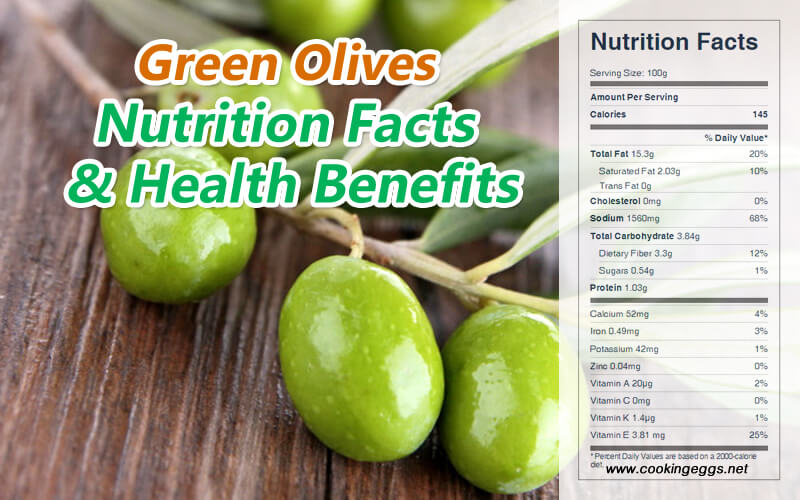Olives Nutrition Facts and Health Benefits
The olive is native to the Mediterranean region, tropical and central Asia, and various parts of Africa. It has been cultivated for more than 4,000 years. Olives are one of the core ingredients in Mediterranean cuisine because they are valued for their fruit and oil. In the Mediterranean, 90% of the olive trees are grown for the oil, while about 10% are used as table olives.
Like the avocado, the olive is eaten as a savory food, but it is actually a fruit. Olive cultivars may be used primarily for oil or eating. The oil varieties significantly outnumber the table varieties. The olive is an oblong fruit, slightly pointed at one end, and one-half to an inch in length. The edible skin is thin and smooth in unprocessed fruits but can be smooth or wrinkled in processed fruits and varies from the yellow-green of unripe olives to dull green, red, yellow, tan, rosy brown, and black, depending on variety, ripeness, and method of processing. The skin covers flesh of the same color, enclosing a hard pit. The flavor of fresh olives is always bitter, but the final flavor depends on both variety and method of processing.
Nutritional Value of Green Olives
Fresh green olives are rich in oleic acid, monounsaturated fats, and high in polyphenols, which give them their bitter flavor and provide antioxidant benefits. During this immature stage, they also contain a high amount of chlorophyll. The fruits are a good source of vitamins E and K and the minerals copper and iron. In addition to containing linoleic, linolenic, and oleic acids and lecithin, olives are an excellent vegan source of protein.
Green olives contain 75% water, 3.8% carbohydrates, 1% protein, and 15% fat.
In a 100-gram reference amount, green olives supply 145 calories, 3.84 g carbohydrate, 1.03 g protein, 15.3 g fat, 3.3 g dietary fiber, 3.81 mg vitamin E, 1.4 µg vitamin K, 14.2 mg choline, 52 mg calcium, 0.49 mg iron, 42 mg potassium, 0.12 mg copper, and 1560 mg sodium.

Green Olives Nutrition Facts Label
Health Benefits of Olives
Olives have antioxidant, antiseptic, demulcent, emollient, laxative, nutritive, and tonic properties. They have been used in treatments for gallstones and gout, and as preventatives for heart disease and ulcers.
Olives are among the fruits with the highest fat content; it is mostly monounsaturated fatty acids(MUFAs). Olive oil is a key component of the Mediterranean diet, which contributes to lower rates of heart disease and obesity. This nutrient is known to help the body regulate its cholesterol levels. It will reduce LDL cholesterol levels, otherwise known as bad cholesterol. It also helps prevent atherosclerosis, which means that the risk of cardiovascular diseases like a heart attack or stroke will be reduced.
Fresh green olives are rich in oleic acid. It is a component of the normal human diet, being a part of animal fats and vegetable oils. Oleic acid may be responsible for the hypotensive (blood pressure reducing) effects of olive oil that are considered a health benefit. A study found that diets enriched in oleic acid are beneficial for regulating body weight.
Olives are rich in vitamin E. It is a fat-soluble antioxidant that includes four tocopherols and four tocotrienols, which may help protect cell membranes from reactive oxygen species. Olives and extra virgin olive oil directly help to reduce oxidation and oxidative damage in the skin, thereby preventing skin damage.
Olive fruit contains several types of polyphenols, mainly tyrosols, phenolic acids, flavonols and flavones, and for black olives, anthocyanins. The main bitter flavor of olives before curing results from oleuropein and its aglycone, which total in content, give them their bitter flavor and provide antioxidant benefits. Antioxidants are useful for helping to prevent chronic diseases and illnesses, as well as mental health deterioration, caused by oxidation. A recent review has suggested that dietary intake of flavonoids is associated with a reduced risk of different types of cancer, including gastric, breast, prostate, and colorectal cancer.
Specific compounds within the olive have been shown to be responsible for its antibacterial activity. For example, aliphatic long-chain aldehydes were active against the G+ and G-bacteria that cause human intestinal and respiratory tract infection. Most studies, however, have found that phenols and phenolic compounds are the main active components, inhibiting bacterial growth as well as having bactericidal (lytic) effects.
Olive extracts have also been shown to have antibacterial effects against drug-resistant variants of Mycobacterium tuberculosis (which causes TB) and to be non-toxic to human cells. Extracts of olive, particularly phenolic compounds, may therefore be useful in the future to treat TB, dermatitis, and nosocomial infections as well as the infections and diseases caused by foodborne and other human pathogenic bacteria.